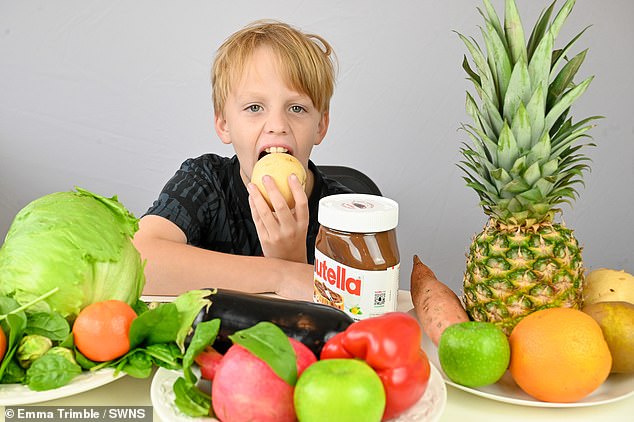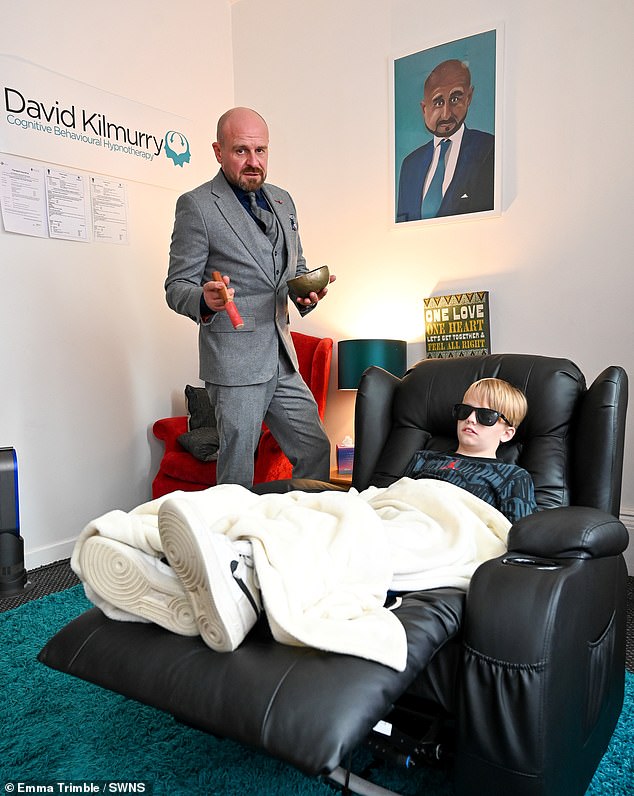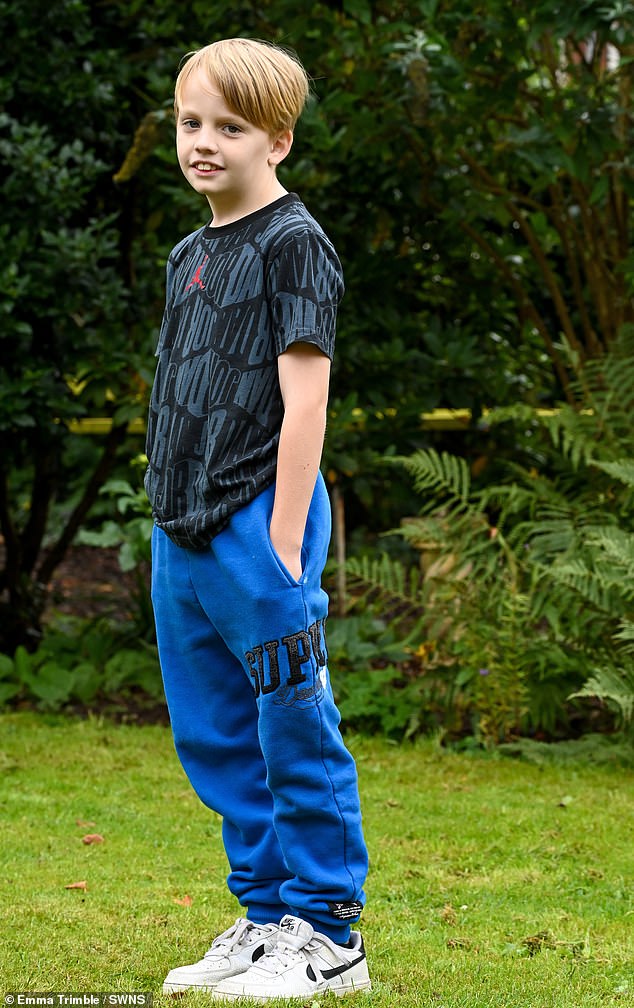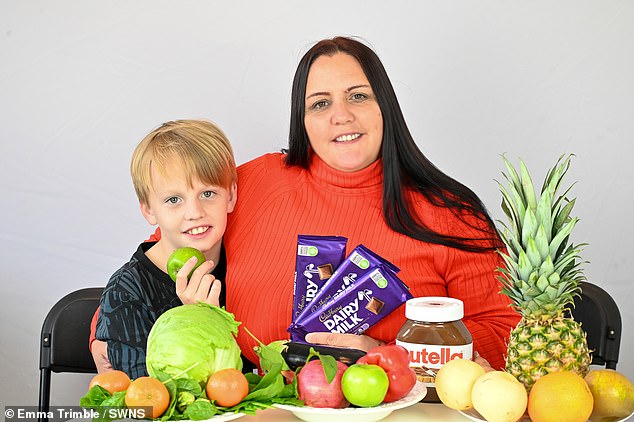‘Fussy’ boy, 8, who lived on chocolate bars, Nutella and Pringles and cried if given chicken nuggets can finally eat normally after being hypnotised
A schoolboy who refused to eat anything other than chocolate and chips can finally eat normally after hypnosis.
Rocco O’Brien, from Ipswich, lived on a diet of Cadbury’s chocolate bars, Nutella spread and salty Pringles crisps – all washed down with Nesquik milk.
The 8 year old would scream and become nauseous if given other foods to try.
Rocco, who suffers from avoidant/restrictive food intake disorder (AFRID), would even burst into tears if forced to hold a chicken nugget or vegetable.
His mother, Heidi, was so desperate for help that she contacted a hypnotherapist who specialized in healing obsessive eating disorders.

Rocco O’Brien, from Ipswich, lived on a diet of Cadbury’s chocolate bars, Nutella spread and salty Pringles crisps – all washed down with Nesquik milk. The 8 year old would scream and become nauseous if given other foods to try. Rocco, who suffers from Avoidant/Restrictive Food Intake Disorder (AFRID), would even burst into tears if forced to hold a chicken nugget or vegetable

His mother, Heidi, was so desperate for help that she contacted a hypnotherapist who specialized in healing obsessive eating disorders. After just a handful of intensive treatment sessions, his diet now includes ten new foods. In the photo Rocco with hypotherapist David Kilmurry
After just a handful of intensive treatment sessions, his diet now includes ten new foods.
Mrs O’Brien, 45, said: ‘Rocco’s anxiety about eating started as soon as we started weaning him.
‘He would gag on everything and avoid certain foods. I was one of those old-fashioned moms who weaned them at four months instead of six months.
‘I tried later, but he wouldn’t eat. Not only did he refuse food, it made him sick.
“We couldn’t go to restaurants, he couldn’t be in the same room eating. The smell, the look.
“I opened his hand and put paste in it and he screamed like I was putting spiders in his hand.”
She added, “He didn’t eat it or anything. Just six months ago, he was holding a chicken nugget and crying.
“He has sensory processing disorder and his senses are heightened. He has been affected by all of them. He is afraid to touch most food.”
Rocco also drank bottles of baby milk until the age of six, Ms O’Brien admitted.
“We went to the dietitian, who suggested Nesquik powder because it contains a lot of vitamins,” she said.
‘The professionals weren’t interested, they were terrible. I came across ARFID and the dietitians and psychologist agreed that this was it. They had never heard of it.
‘I’m a mother and they looked at it like it was my fault. They said I basically had to starve him. I fought with them.’
Those affected by ARFID can only eat a very limited number of foods that do not cause severe aversion.
More extreme than picky eating, the condition can cause people to vomit, choke or become fearful or angry around food, according to eating disorder charity Beat.
It differs from conditions such as anorexia and bulimia because it is not linked to body image. Instead, it’s more of a physical aversion to food.
The condition was only recognized in 2013, after it was included in the American Diagnostic and Statistical Manual of Mental Disorders (DSM), which is widely regarded as the ‘bible’ of psychiatrists.
The foods that people with ARFID eat typically include basic carbohydrates such as bread and dry cereals, chips, cookies, chocolate and yogurt.
People with ARFID can also be very specific about which brands and flavors they like.
There is little reliable data on the number of people with the condition, but preliminary studies have shown that it affects an estimated 3.2 percent of the general population.
ARFID is thought to become apparent around the age of four – often when solid foods are introduced, especially lumpy or textured foods that could make a baby gag.
Mrs O’Brien said: ‘He has autism and many autistic children are on a beige diet. This was much more.

Those affected by ARFID can only eat a very limited number of foods that do not cause severe aversion. More extreme than picky eating, the condition can cause people to vomit, choke or become fearful or angry around food, according to eating disorder charity Beat. It differs from conditions such as anorexia and bulimia because it is not linked to body image. Instead, it’s more of a physical aversion to food. In the photo, Rocco

Currently, treatment for the condition is not included in the NICE guidelines for eating disorders. But evidence-based treatments such as family treatment – for youth – cognitive behavioral therapy, behavioral interventions such as exposure work and anxiety management training are known to work, Beat said. In the photo Rocco with his mother Heidi
“He ate a beige diet of dry cream crackers and bourbon biscuits. Then it started to become chocolate. Cocopops and chocolate.
‘His diet consists of chocolate spread sandwiches, coconuts, quavers, ready-made salted Pringles, breadsticks and rolls.
‘It just depends on what he feels. It could be two jars of Pringles in the morning. It could be coconuts at night.”
Mrs O’Brien, who has four other children with husband Chris, 45, added: ‘A few weeks ago we were camping at a caravan park and the girl in the shop asked for Rocco as we were trying to find him something to eat.
‘She asked if he had ARFID and said she had it but was now cured after meeting David. I booked a session with Rocco that evening.
‘After just two sessions he had tried baby spinach, apple and pear. These are things he would never try.”
An intensive and specialized treatment approach is usually required to treat ARFID.
Currently, treatment for the condition is not included in the NICE guidelines for eating disorders.
But evidence-based treatments such as family treatment – for youth – cognitive behavioral therapy, behavioral interventions such as exposure work and anxiety management training are known to work, Beat said.
Treatments may also include medication or nutritional management through support from a dietitian, and help with sensory problems.
Mrs O’Brien said: ‘I used to pile it on his plate. He tried a different cracker at home, with a different texture.
‘He likes that now. He tries things like crackers, but different.”
Meanwhile, hypnotherapist David Kilmurry said: ‘It was an honor to meet and work with Rocco and his family, who have come a long way here, which is an achievement in itself with autism.
‘Rocco was very relaxed and happy to eat the food straight away after the hypnosis. It was a joy to watch him eat pears as if he had been eating them all his life.’
